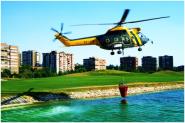Source:
Technical igK Dpt.
16 December 2013
Environmental benefits of Turfgrass (II)
The environmental benefits of turfgrasses are also about efficient irrigation in its extensive culture, and positively affect the water cycle. Also suitable are, like other plant surfaces and areas, as mitigating global warming.
 Agua disponible y cercana para la contención de incendios
Agua disponible y cercana para la contención de incendios
Soil, water and plants work collaboratively to mantain the habitat, promoting environmental balance.
Organic chemical compounds degradation: The decomposition of turfgrass roots, rhizomes and stolons, sustains a large part of the microorganisms in the soil, which degrade by feeding on organic chemical compounds, including pesticides.
Phytoremediation: This practice consists in reestablishing or regenerating degraded and contaminated soils or improving air and water quality with plants capable of containing, degrading or eliminating metals, explosive residues, petroleum byproducts, problems associated with old landfills or any other type of pollutant. This is an efficient, clean and cheap means, in which different turfgrass species can be used ,for example,Ryegrass to eli minate Cadmium accumulations in the soil(*).
Part of this practice is the phytoextraction, a process in which the plant simply accumulates the polluting element in its biomass.
Phytotransformation is another much more interesting process, in which the plant's metabolism causes a chemical change that inactivates, degrades or immobilizes the polluting effect of the substance at issue.
Favorable habitat for developing the fauna:Obviously the construction phase of the sports field or a garden creates a negative environment in this regard. However, once it has been established and native plants can be used in areas adjacent to the turfgrass, favorable conditions are created for increasing animal biodiversity (especially bird life).
Noise and glare reduction: Turfgrass next to residential zones or airports is able to diminish or abate the noise caused by circulating vehicles, aircraft or industrial activities. Turfgrass also reflects light multi-directionally, reducing visual stress caused by brightness.
Fire contention: Lakes found in sports fields are available water sources that are close at hand when putting out a forest fire. The size of the field itself can also serve as a very effective firebreak.
(*)Yu-Jen, K. 2002. Evaluation of Cadmium uptake and growth inhibition of three turfgrass species. Department of Landscape Architecture. Chinese Culture University, Taipei, Taiwan. ROC